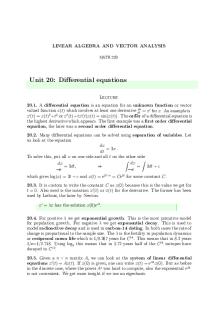Hernia - teaching summary PDF

| Title | Hernia - teaching summary |
|---|---|
| Course | Introductory Surgery |
| Institution | Universiti Putra Malaysia |
| Pages | 7 |
| File Size | 86.4 KB |
| File Type | |
| Total Downloads | 96 |
| Total Views | 127 |
Summary
teaching summary...
Description
Hernia Protrusion of an organ through opening in the wall of cavity in which it is normally contained
Risk Factor
Male
Elderly
Previous hernia
Chronic cough
Chronic constipation
Abdominal wall weakness
Smoking
Sign & Symptom
Visible lump
Heavy discomfort around gut
Pain on exertion
Constipation
Lump enlarge upon coughing
Causes
Congenital : o
Patent processus vaginalis
Acquired : o
Trauma
o
Surgical incision
Types
Inguinal hernia o
Direct
o
Indirect
o
Pantaloon (direct + indirect)
Femoral hernia
Insional hernia
Parastomal hernia
Umbilical hernia
Epigastric hernia
Complications
Irreducible : content of hernia sac cannot be replaced into abdomen
Incarcerated
Obstructed : loop of bowel trapped in hernia sac
Strangulated : blood supply to trapped bowel is cutted off > dead / gangrene
Inguinal Hernia Indirect Inguinal Hernia
Congenital ; patent processus vaginalis + weakened fascia at deep ring
Hernia sac enters inguinal canal via deep ring, emerges to superficial ring, descend into scrotum
Lateral to inferior epigastric artery
More common in young adult, infants
May cause strangulation at superficial ring (narrow)
Does not readily reduce on lying down
Reduce upward, laterally, backward
Controlled after reduction by pressure over deep ring
Direct Inguinal Hernia
Weak abdominal muscle
Comorbid condition causing increase intraabdominal pressure
Bulges directly through weakened fascia within Hesselbach triangle o
Lateral : inferior epigastric artery
o
Medial : rectus abdominis sheath
o
Inferior : inguinal ligament
Medial to inferior epigastric artery
More common in elderly
Rarely cause strangulation due to wide hernia neck
Readily reduce on lying down
Reduce upward and straight backward
Controlled after reduction by pressure over superficial ring
Inguinal Canal :
4-6cm long, oblique passage
Above inguinal ligament
Form deep to superficial ring
Deep ring : midpoint of inguinal ligament (ASIS to pubic tubercle)
Superficial ring : triangular defect in aponeurosis of external oblique
Structure passing through inguinal canal : o
Spermatic cord
3 concentric layers of fascia :
Transversalis fascia -> internal spermatic fascia
Internal oblique -> cremasteric fascia and muscle
External oblique -> external spermatic fascia
3 arteries :
Testicular artery
Artery to vas deferens
Cremasteric artery
o
3 nerves :
Nerve to cremaster
Autonomic nerve (T10)
Genital branch of genitofemoral nerve
3 others :
Vas deferens
Pampinifirm venous plexus
lymphatics
Round ligament of uterus
Management Inguinal Hernia Non Surgical
Reduce intraabdominal pressure : o
Weight loss
o
Avoid heavy lifting
o
Treat medical condition : chronic cough, chronic constipation
Truss
Obstructed / strangulated : o
Nil by mouth
o
IV drip
o
NG tube on suction
o
IV antibiotic
o
Emergency surgery
Surgical (Open / Laparoscopic surgery)
Herniotomy : removal of hernia sac without repair of inguinal canal
Herniorraphy : repair of posterior wall on inguinal canal + herniotomy
o
Bassini repair
o
Shouldice repair
o
Desarda
Hernioplasty (Gold Standard) : herniotomy + reinforcement of posterior wall of inguinal canal with synthetic mesh o
Lichtenstein
Principles of Surgery
Reduce bowel
+/- excise hernia sac
Reinforce posterior wall
Type of Laparoscopic Surgery
Transabdominal Preperitoneal Repair (TAPP)
Total Extraperitonela Repair (TEP)
Complication of Surgery
GA complication
Immediate : o
Acute urinary retention
o
Bleeding, bruising
o
Injury to surrounding structure
Early : o
Infected wound, mesh
o
Hematoma
o
Wound dehiscence
o
Pain
Late : o
o
Recurrence hernia
Poor technique of wound closure
Incomplete dissection
Too early mobilization
Uncontrolled comorbidity
Ischemic orchitis and testicular atrophy
Post-Op Monitoring
Avoid heavy lifting
Treat medical condition
Early mobilization from Day10
Keep area clean and wash carefully
Umbilical Hernia
Women >40 years old
Weakness of linea alba, contain greater omentum
Risk Factor :
Pregnancy
Ascites
Pelvic mass / intraabdominal mass eg, fibroid
Obesity
Surgery : Mayo’s vest over pants operation
Femoral Hernia
Higher risk of strangulation (narrow opening)
Surgery : lotheissen’s Operation
Differential Diagnosis :
Inguinal hernia
Saphena varix
Enlarged femoral lymph node
Lipoma
Femoral aneurysm...
Similar Free PDFs

Hernia - teaching summary
- 7 Pages

Hernia Examination
- 3 Pages

Askep hernia
- 11 Pages

Hernia Inguinalis Ppt
- 30 Pages

CONCEPT MAP PENYAKIT HERNIA
- 1 Pages

CONTOH ASKEP HERNIA
- 1 Pages

LAPORAN PENDAHULUAN HERNIA
- 15 Pages

Eponimos hernia inguinales
- 12 Pages

Hernia Scrotalis Reponibel Dextra
- 21 Pages

LP askep Hernia docx
- 17 Pages

makala tentang penyakit hernia
- 15 Pages
Popular Institutions
- Tinajero National High School - Annex
- Politeknik Caltex Riau
- Yokohama City University
- SGT University
- University of Al-Qadisiyah
- Divine Word College of Vigan
- Techniek College Rotterdam
- Universidade de Santiago
- Universiti Teknologi MARA Cawangan Johor Kampus Pasir Gudang
- Poltekkes Kemenkes Yogyakarta
- Baguio City National High School
- Colegio san marcos
- preparatoria uno
- Centro de Bachillerato Tecnológico Industrial y de Servicios No. 107
- Dalian Maritime University
- Quang Trung Secondary School
- Colegio Tecnológico en Informática
- Corporación Regional de Educación Superior
- Grupo CEDVA
- Dar Al Uloom University
- Centro de Estudios Preuniversitarios de la Universidad Nacional de Ingeniería
- 上智大学
- Aakash International School, Nuna Majara
- San Felipe Neri Catholic School
- Kang Chiao International School - New Taipei City
- Misamis Occidental National High School
- Institución Educativa Escuela Normal Juan Ladrilleros
- Kolehiyo ng Pantukan
- Batanes State College
- Instituto Continental
- Sekolah Menengah Kejuruan Kesehatan Kaltara (Tarakan)
- Colegio de La Inmaculada Concepcion - Cebu




